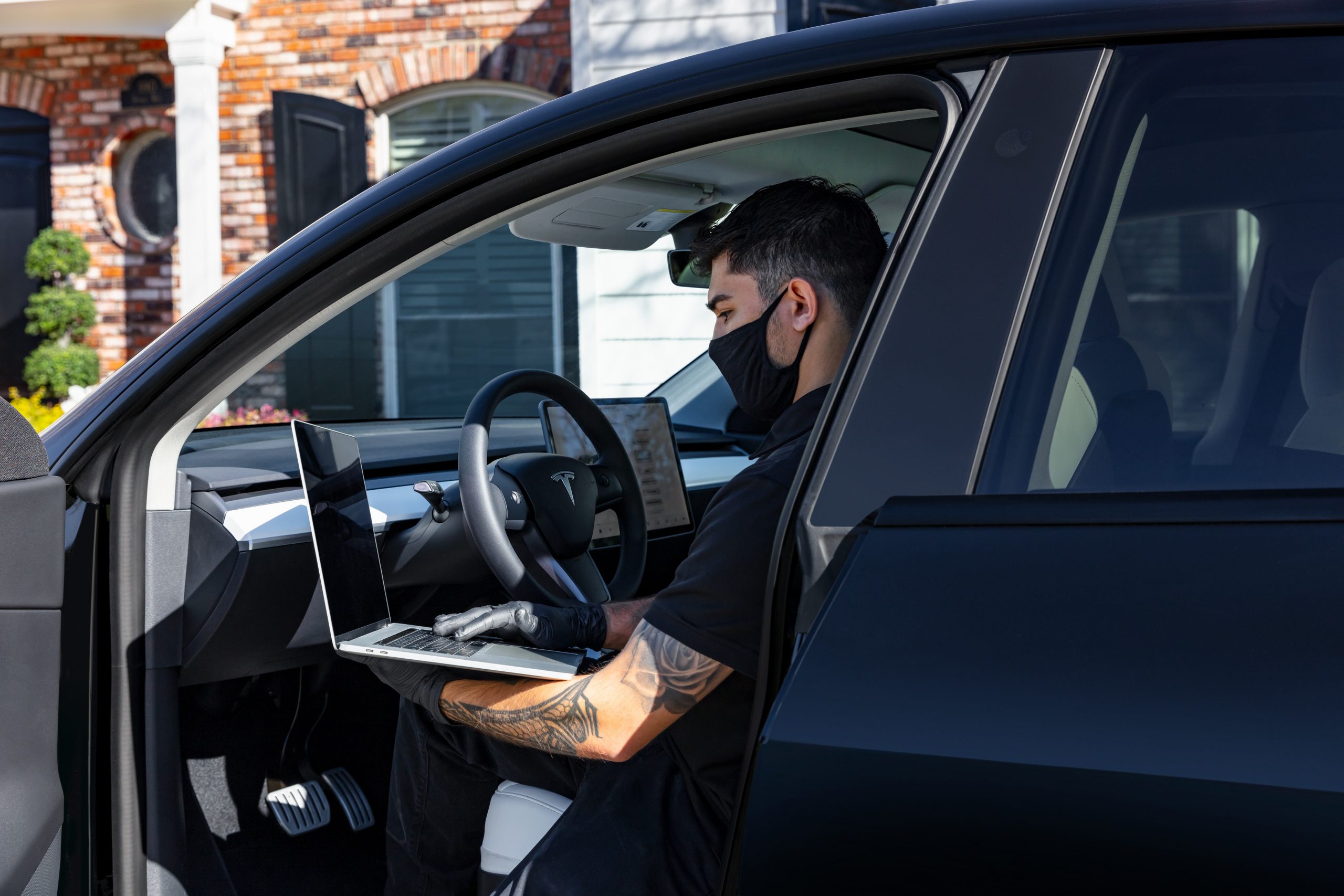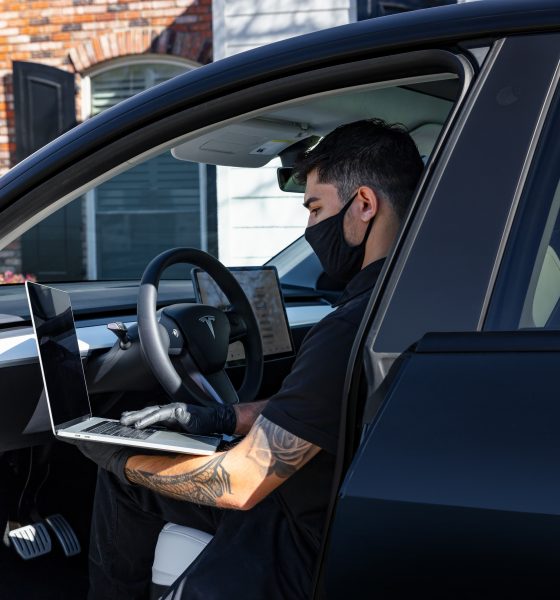Tesla CEO Elon Musk said yesterday during the Q4 2021 Earnings Call that the automaker is pushing California to adopt telematics-based insurance rates. Ricardo Lara, the State’s Insurance Commissioner, is advising Musk to ease off.
Telematics insurance adjusts the price of premiums based on usage. It usually can use plug-in devices or a mobile application to track driving behaviors and overall usage and can adjust a monthly insurance premium based on these behaviors. Tesla’s telematic’s system is available in four of the five states it offers its in-house insurance program: Texas, Illinois, Ohio, and Arizona. California is the lone state that refuses to adopt the system.
During yesterday’s Earnings Call, Musk said that Tesla is pushing hard for California to allow telematics for its insurance program.
“It should be clear, like we are pushing very hard for California to change the rules to allow informatics, which basically means that, you know, you’re as safe as you’re driving is measured,” Musk said. “So I think the current California rules are contrary to the best interest of the consumers in California and should be changed.”
CFO Zachary Kirkhorn added that telematics and informatics insurance programs have contributed to safer driving, at least in Texas. “We’ve been in this market now for about three months,” Kirkhorn said. “And what we see in the data is the frequency of collision by folks who are given a feedback loop on how they are driving is quite a bit lower than the frequency of collision otherwise.”
Musk broadened on his points. “We get direct feedback on whether driving is safe. And if they drive safe, their insurance cost is less, so they drive safer,” Musk added. “It encourages Tesla insurance with informatics, and real-time feedback encourages safer driving and rewards it monetarily.”
Telematics can encourage safer driving as more cautious behaviors while operating a vehicle, like traveling at a safe speed and maintaining plenty of distance to avoid occurrences of emergency braking, can lower monthly rates. However, there are disadvantages to the program, as it can be considered a breach of privacy. California’s Insurance Commissioner, Ricardo Lara, says Tesla should “push all [they] want,” but the State has no plans to adopt the system.
The Department of Insurance continues to uphold and implement the consumer protections set forth in voter-enacted Proposition 103 & since 2009 we have allowed vehicle data only to determine actual miles driven, and only in a way that protects the driver’s privacy. (2/2)
— Ricardo Lara (@ICRicardoLara) January 27, 2022
“Yesterday @elonmusk reportedly told investors he’s ‘pushing very hard’ to change the rules on telematics for California drivers. Push all you want, but we won’t bend on protecting consumer data, privacy, and fair rates,” Lara said in a tweet earlier today. Lara, who took office in 2018, states one of the main priorities as Commissioner is to ensure a fair insurance market while embracing new technology.
“Technology is touching every aspect of our lives. We need to embrace new technology to improve access, affordability, and privacy, while promoting creativity and allowing innovation to transform the industry,” the Commissioner is quoted as saying on California’s Insurance website.
Telematics dates back to 1978 but is used commonly, especially in commercial fleets to track containers or tractor-trailers. In insurance, the technology is relatively new and was first patented by Progressive Casualty Insurance Company in 1998. In 2010, the first worldwide family litigation was filed for the patent. While it encourages safe driving and has customizable programs that determine rates on either behavior or total usage, it could be considered invasive. It requires drivers to share information that is somewhat personal, including where a car is at a particular time. Additionally, it is costly to implement as it requires GPS or camera-based technology to monitor behaviors and determine rates.
I’d love to hear from you! If you have any comments, concerns, or questions, please email me at joey@teslarati.com. You can also reach me on Twitter @KlenderJoey, or if you have news tips, you can email us at tips@teslarati.com.
Quotes provided by The Motley Fool.

News
Tesla FSD fleet is nearing 7 billion total miles, including 2.5 billion city miles
As can be seen on Tesla’s official FSD webpage, vehicles equipped with the system have now navigated over 6.99 billion miles.

Tesla’s Full Self-Driving (Supervised) fleet is closing in on almost 7 billion total miles driven, as per data posted by the company on its official FSD webpage.
These figures hint at the massive scale of data fueling Tesla’s rapid FSD improvements, which have been quite notable as of late.
FSD mileage milestones
As can be seen on Tesla’s official FSD webpage, vehicles equipped with the system have now navigated over 6.99 billion miles. Tesla owner and avid FSD tester Whole Mars Catalog also shared a screenshot indicating that from the nearly 7 billion miles traveled by the FSD fleet, more than 2.5 billion miles were driven inside cities.
City miles are particularly valuable for complex urban scenarios like unprotected turns, pedestrian interactions, and traffic lights. This is also the difference-maker for FSD, as only complex solutions, such as Waymo’s self-driving taxis, operate similarly on inner-city streets. And even then, incidents such as the San Francisco blackouts have proven challenging for sensor-rich vehicles like Waymos.
Tesla’s data edge
Tesla has a number of advantages in the autonomous vehicle sector, one of which is the size of its fleet and the number of vehicles training FSD on real-world roads. Tesla’s nearly 7 billion FSD miles then allow the company to roll out updates that make its vehicles behave like they are being driven by experienced drivers, even if they are operating on their own.
So notable are Tesla’s improvements to FSD that NVIDIA Director of Robotics Jim Fan, after experiencing FSD v14, noted that the system is the first AI that passes what he described as a “Physical Turing Test.”
“Despite knowing exactly how robot learning works, I still find it magical watching the steering wheel turn by itself. First it feels surreal, next it becomes routine. Then, like the smartphone, taking it away actively hurts. This is how humanity gets rewired and glued to god-like technologies,” Fan wrote in a post on X.
News
Tesla starts showing how FSD will change lives in Europe
Local officials tested the system on narrow country roads and were impressed by FSD’s smooth, human-like driving, with some calling the service a game-changer for everyday life in areas that are far from urban centers.

Tesla has launched Europe’s first public shuttle service using Full Self-Driving (Supervised) in the rural Eifelkreis Bitburg-Prüm region of Germany, demonstrating how the technology can restore independence and mobility for people who struggle with limited transport options.
Local officials tested the system on narrow country roads and were impressed by FSD’s smooth, human-like driving, with some calling the service a game-changer for everyday life in areas that are far from urban centers.
Officials see real impact on rural residents
Arzfeld Mayor Johannes Kuhl and District Administrator Andreas Kruppert personally tested the Tesla shuttle service. This allowed them to see just how well FSD navigated winding lanes and rural roads confidently. Kruppert said, “Autonomous driving sounds like science fiction to many, but we simply see here that it works totally well in rural regions too.” Kuhl, for his part, also noted that FSD “feels like a very experienced driver.”
The pilot complements the area’s “Citizen Bus” program, which provides on-demand rides for elderly residents who can no longer drive themselves. Tesla Europe shared a video of a demonstration of the service, highlighting how FSD gives people their freedom back, even in places where public transport is not as prevalent.
What the Ministry for Economic Affairs and Transport says
Rhineland-Palatinate’s Minister Daniela Schmitt supported the project, praising the collaboration that made this “first of its kind in Europe” possible. As per the ministry, the rural rollout for the service shows FSD’s potential beyond major cities, and it delivers tangible benefits like grocery runs, doctor visits, and social connections for isolated residents.
“Reliable and flexible mobility is especially vital in rural areas. With the launch of a shuttle service using self-driving vehicles (FSD supervised) by Tesla in the Eifelkreis Bitburg-Prüm, an innovative pilot project is now getting underway that complements local community bus services. It is the first project of its kind in Europe.
“The result is a real gain for rural mobility: greater accessibility, more flexibility and tangible benefits for everyday life. A strong signal for innovation, cooperation and future-oriented mobility beyond urban centers,” the ministry wrote in a LinkedIn post.
News
Tesla China quietly posts Robotaxi-related job listing
Tesla China is currently seeking a Low Voltage Electrical Engineer to work on circuit board design for the company’s autonomous vehicles.

Tesla has posted a new job listing in Shanghai explicitly tied to its Robotaxi program, fueling speculation that the company is preparing to launch its dedicated autonomous ride-hailing service in China.
As noted in the listing, Tesla China is currently seeking a Low Voltage Electrical Engineer to work on circuit board design for the company’s autonomous vehicles.
Robotaxi-specific role
The listing, which was shared on social media platform X by industry watcher @tslaming, suggested that Tesla China is looking to fill the role urgently. The job listing itself specifically mentions that the person hired for the role will be working on the Low Voltage Hardware team, which would design the circuit boards that would serve as the nervous system of the Robotaxi.
Key tasks for the role, as indicated in the job listing, include collaboration with PCB layout, firmware, mechanical, program management, and validation teams, among other responsibilities. The role is based in Shanghai.
China Robotaxi launch
China represents a massive potential market for robotaxis, with its dense urban centers and supportive policies in select cities. Tesla has limited permission to roll out FSD in the country, though despite this, its vehicles have been hailed as among the best in the market when it comes to autonomous features. So far, at least, it appears that China supports Tesla’s FSD and Robotaxi rollout.
This was hinted at in November, when Tesla brought the Cybercab to the 8th China International Import Expo (CIIE) in Shanghai, marking the first time that the autonomous two-seater was brought to the Asia-Pacific region. The vehicle, despite not having a release date in China, received a significant amount of interest among the event’s attendees.










